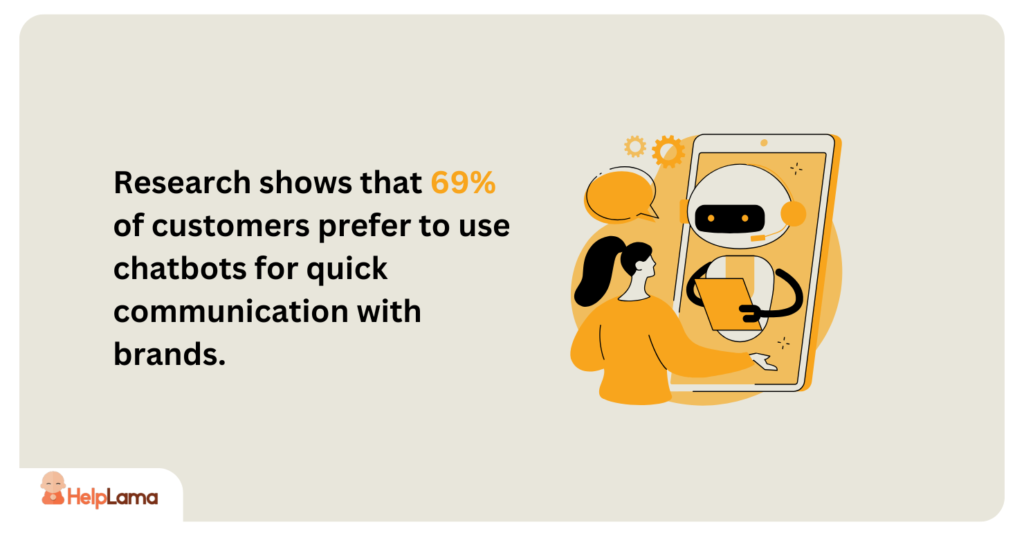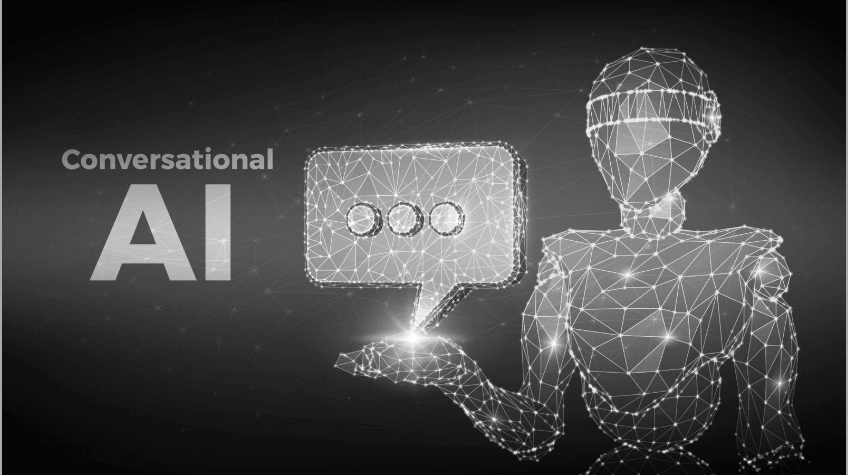Last Updated: April 2025
Customer service is evolving rapidly to meet the growing expectations of modern consumers. Today, businesses face increasing pressure to provide fast, efficient, and personalized support. The rise of Conversational AI and the continued importance of live agents have reshaped how companies approach customer service.
Research shows that 69% of customers prefer to use chatbots for quick communication with brands. While AI offers quick and consistent support, human agents provide emotional intelligence and problem-solving that technology cannot replicate.
Finding the right balance between conversational AI vs. live agents is crucial for delivering an exceptional customer experience. This article explores the strengths and limitations of both approaches, helping businesses determine the ideal mix to enhance customer satisfaction and operational efficiency.
What is Conversational AI?
Conversational AI refers to artificial intelligence systems designed to engage with users through natural language. It uses Natural Language Processing (NLP) and machine learning to understand, process, and respond to customer queries. Common examples include chatbots, virtual assistants, and voice-based systems.
These AI systems have become more sophisticated over the years. Early versions could only handle simple, rule-based conversations. Modern conversational AI, however, adapts to context, learns from past interactions, and delivers more accurate, human-like responses.
The main goal of conversational AI is to automate customer service by handling routine questions and providing quick answers. This reduces the workload on human agents, allowing them to focus on complex issues that require critical thinking and emotional intelligence.
The Evolution of Conversational AI
Originally, solely keyword-based responses and programmed conversations were the AI-based customer service that a company could use. Subsequently, however, with the help of advanced machine learning and data analytics techniques, AI has managed to delve deeply into analyzing lots of customer conversations and acquiring knowledge of how they are structured. Because of this, AI becomes able to find trends in customer queries, recognize them, and consequently develop its feedback, which, as a result, will be more accurate.
Currently, AI can also determine not only whether the customer is happy or unhappy but also what the customer’s voice is communicating and thus rephrasing its responses appropriately. Thanks to that, AI is able to notice when a customer is annoyed and therefore change its approach to make it more understanding, though it does not have feelings.
From the rule-based approach we always had towards conversational AI to an adaptive learning one our service becomes more effective. Today, not only can AI give answers, but it can also provide additional contextually relevant suggestions based on previous interactions.
Key Features of Conversational AI
Conversational AI offers several key features that make it a valuable asset in customer service:
- 24/7 Availability: AI operates round the clock, providing support even during non-business hours.
- Scalability: AI can handle thousands of customer inquiries simultaneously without slowing down.
- Consistency: AI ensures that customers receive the same information and service quality every time.
- Personalization: AI can tailor responses based on customer data, including previous interactions and preferences.
- Integration: AI integrates seamlessly with CRM systems and other business tools, streamlining service operations.
Benefits of Using Conversational AI for Customer Service
The benefits of using conversational AI in customer service are substantial:
- Reduced Costs: AI reduces staffing costs by handling routine tasks, and cutting down on hiring and training expenses.
- Faster Response Times: AI provides instant answers, reducing customer wait times and improving satisfaction.
- Improved Efficiency: By automating repetitive tasks, AI allows human agents to focus on more complex problems.
- Data Collection and Analysis: AI gathers valuable customer data that can be used to improve products and services.
- Consistency in Responses: AI eliminates human errors and ensures uniform communication.
While conversational AI offers significant advantages, it’s not a complete replacement for human agents, especially when it comes to emotional intelligence and complex problem-solving.
The Role of Live Agents in Customer Service
Despite the rise of AI, live agents remain a vital part of customer service. Human interaction is irreplaceable when it comes to handling sensitive or complex issues. Customers value speaking with a person who can empathize with their frustrations and provide tailored solutions.
Live agents bring emotional intelligence, adaptability, and creativity to the table. Unlike AI, they can understand nuances in tone, sarcasm, and context, and adjust their approach accordingly.
The Importance of Human Touch in Customer Interactions
No matter how advanced AI becomes, it cannot replicate the emotional connection that comes from human interaction. Customers are more likely to trust a company when they feel heard and valued.
Live agents can actively listen to customer concerns, ask clarifying questions, and adjust their tone to match the customer’s emotional state. A calm, reassuring tone can make a significant difference when a customer is upset or frustrated.
This emotional connection builds customer loyalty and encourages repeat business. AI may provide quick answers, but only humans can offer genuine empathy and reassurance.
Skills and Abilities of Live Agents
Live agents bring several essential skills to customer service:
- Critical Thinking: Agents can analyze complex problems and come up with creative solutions.
- Emotional Intelligence: Humans can detect subtle changes in tone and respond with empathy.
- Adaptability: Agents can adjust their approach based on the customer’s personality and emotional state.
- Decision-Making: Unlike AI, agents can make judgment calls in ambiguous situations.
- Negotiation Skills: Human agents can handle disputes and find win-win solutions.
Advantages of Live Agents in Customer Service
Human agents excel in areas where AI falls short:
- Handling Complex Issues: Live agents are better equipped to handle multi-layered problems.
- Emotional Support: A human touch can de-escalate tense situations and reassure customers.
- Relationship Building: Personal interactions foster long-term customer loyalty.
- Flexibility: Live agents can adapt to unexpected issues and changing customer needs.
- Sales and Upselling: Humans can suggest products and services based on real-time conversations.
Comparing Conversational AI vs. Live Agents
When comparing conversational AI vs. live agents, it’s clear that both have distinct strengths. The key to success lies in combining their capabilities effectively.
Feature | Conversational AI | Live Agents |
Availability | 24/7 | Limited to business hours |
Speed | Instant | Slower |
Cost | Lower (scales easily) | Higher (requires staffing) |
Emotional Intelligence | Simulated (through NLP) | Genuine (real empathy) |
Complexity Handling | Limited | High |
Scalability | High | Limited |
Flexibility | Moderate (based on training) | High (creative problem-solving) |
Striking the Perfect Balance
The ideal approach involves a hybrid model that leverages the strengths of both AI and human agents.
Determining the Right Mix
Businesses should assess their service volume and customer needs:
- High-volume, low-complexity inquiries = Best handled by AI.
- Low-volume, high-complexity issues = Best handled by human agents.
AI can handle order tracking, FAQs, and basic troubleshooting, while live agents can address escalations and unique customer concerns.
Training and Integration for a Balanced Approach
For a hybrid model to succeed, businesses must invest in training and integration:
- Agents need to know when to escalate issues to AI and vice versa.
- AI systems should be regularly updated based on customer feedback.
- Human agents should receive training on how to work alongside AI effectively.
Measuring Success in a Hybrid Model
Success should be measured through key performance indicators (KPIs):
- Customer Satisfaction Scores (CSAT): Measures how satisfied customers are with the service.
- Response Time: Tracks how quickly issues are resolved.
- Resolution Rate: Measures how many problems are solved on the first interaction.
- Net Promoter Score (NPS): Measures how likely customers are to recommend the service.
Conversational AI Chatbot Examples
Conversational AI chatbots are transforming customer interactions across industries by automating responses and providing quick, accurate answers. Businesses are increasingly adopting these chatbots to improve efficiency, reduce costs, and enhance customer satisfaction. Here are five notable examples of conversational AI chatbots in action:
- ChatGPT – OpenAI’s ChatGPT is not a mere mechanical chatbot but a highly advanced conversational AI that is very impressive. It uses sophisticated machinery known as deep learning to mimic human responses. It can handle complex text conversations, be creative with its responses, and assist in customer service functions
- Alexa – Amazon’s Alexa is now a voice-activated conversational AI assistant. It is equipped with smart home devices and understands natural language, and besides that, it can answer questions, play music, and send weather updates wherever you are at the moment.
- Google Assistant – Google Assistant syncs with the Google data ecosystem and relies on the data network to tailor the answers to the searcher, set reminders, answer questions, and even act as a two-way messenger.
- Watson Assistant – In fact, IBM’s Watson Assistant is a business-oriented chatbot, that is generally used for business. It connects with CRM systems and other business applications to handle customer service inquiries and automate business processes
- Drift – Drift is a conversational AI chatbot solution that is specifically designed for the sales and marketing departments. It uses AI and can have live chats with the website visitors, qualifying leads, and directing the conversations to the correct sales representative when needed.
These conversational AI chatbot examples highlight how businesses can leverage AI to automate customer interactions, reduce response times, and improve user engagement. The success of these chatbots depends on their ability to understand context, personalize responses, and provide seamless integration with other business systems.
Live Chat Support Examples
Live chat support remains a crucial part of customer service, providing real-time human interaction to resolve customer issues. Unlike chatbots, which rely on automation and artificial intelligence, live chat connects customers with human agents who can understand emotional cues and provide tailored solutions. Here are five notable examples of successful live chat support:
- Zappos – The brand Zappos is much appreciated for its customer support strategy. The live chat feature introduced by the company enables customers to talk to knowledgeable agents who assist them with product recommendations, order tracking, and returns.
- Shopify – Developing the live chat customer service function is the focus of Shopify, which in turn helps the store owners get the technical support and business strategy advice they need. The live chat team imparts their knowledge and expertise and has been trained in both product questions and Internet sales activities.
- Apple – Their live chat customer support is dedicated to solving hardware and software issues for customers. The staff members are well-trained and can give an easy-to-follow guide through technical problem-solving. The live chat function will allow customers to upload screen videos and screenshots for an accurate diagnosis.
- Nordstrom – Answering customers’ questions through live chat is a unique way for Nordstrom to encourage tailor shopping. Clients can converse with a stylist or sales assistant who can suggest the products that they would like and have bought in the past.
- Zendesk – The live chat platform from Zendesk is a very useful tool in connecting companies with customer service systems. The use of the live chat feature in Zendesk by companies can make customer service inquiries, provide more complicated matters to supervisors, and keep a close watch on customer satisfaction levels.
The key advantage in the live chat vs chatbot comparison is emotional intelligence and flexibility. While chatbots handle high-volume, repetitive tasks efficiently, live chat support excels in handling complex issues and providing a human touch. Live agents can understand emotional cues, offer personalized solutions, and build customer trust, making live chat essential for maintaining customer satisfaction and loyalty.
Helplama – Best Outsourced Live Chat Agents
Helplama offers high-quality outsourced live chat agents to help businesses manage customer interactions efficiently. Their agents are trained to handle complex queries with professionalism and empathy, ensuring a personalized customer experience. Helplama combines AI automation with human support for seamless escalation when needed.
Key Features:
- 24/7 Availability: Ensures round-the-clock customer support.
- Multichannel Integration: Supports live chat, email, phone, and social media.
- Performance Tracking: Provides real-time monitoring and analysis.
- Custom Training: Agents are trained to align with your brand’s tone and style.
- Flexible Pricing: Pay-as-you-go and performance-based options.
Conclusion
In the debate of conversational AI vs. live agents, there is no one-size-fits-all solution. AI provides speed, efficiency, and cost savings, while live agents deliver emotional intelligence and complex problem-solving. By combining the two in a well-balanced hybrid model, businesses can deliver fast, consistent, and emotionally engaging customer service, ensuring both operational efficiency and customer loyalty.
Businesses that integrate AI with human support see a 30% reduction in customer service costs and a 25% increase in customer satisfaction due to faster resolution times and personalized service.
To explore a seamless blend of AI and human support, try Helplama. Their platform combines automation with human insight to deliver fast, personalized customer service.







